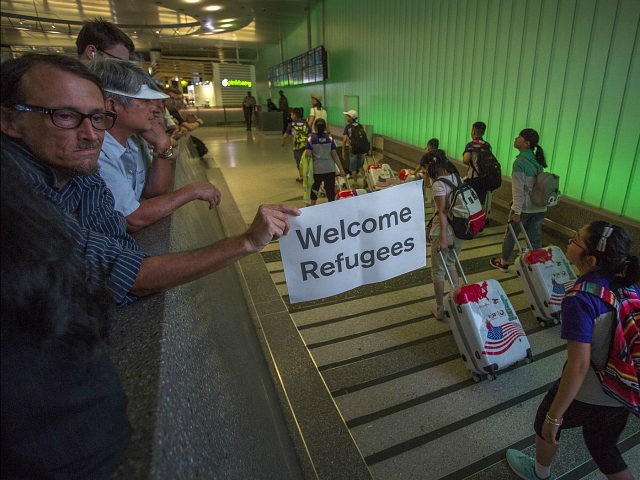Reuters reported last week that the White House Domestic Policy Council “is taking the lead on a decision about how many refugees to admit to the United States next year.”
The Domestic Policy Council reports to Stephen Miller, senior adviser to President Trump on domestic policy and a former member of Attorney General Jeff Sessions’ staff when he served in the United States Senate.
The report is not surprising, given the president’s statutory role under the Refugee Act of 1980 in making an official determination of the ceiling for the number of refugees allowed into the country through the federal refugee resettlement program prior to the beginning of each fiscal year (FY).
Traditionally, the president makes the official determination of the refugee ceiling number in September, the last month of the preceding fiscal year.
That determination represents a top ceiling the program cannot exceed, in the president’s view, but is not a required level to reach. It is completely possible that the number of refugees resettled in the country is below that ceiling.
The actual number of refugees who arrive in a given fiscal year is the result of the appropriations authorized for the program by Congress for that fiscal year after the president announces his official determination.
In the more than thirty years the program has been operational, Congress typically funds the program for any given fiscal year to support refugee arrivals at or below the presidential ceiling determination announced by the president in September.
President Obama recommended a ceiling of 85,000 for FY 2016 in September 2015, and Congress funded the program for FY 2016, which began on October 1, 2015, and continued until September 30, 2016, to enable 84,995 refugees to arrive in the United States.
FY 2017 has been one of the most unusual years in the history of the federal refugee resettlement program.
President Obama recommended an increase of the ceiling to 110,000 refugees for FY 2017 in September 2016, but Congress failed to finalize the FY 2017 budget until May 2017, four months into the administration of President Donald Trump.
When Congress passed the continuing budget resolutions to keep the government operational for months at a time, rather than the full fiscal year, refugee resettlement funding was capped at FY 2016 levels, meaning there was not sufficient money to fund the 29 percent increase in refugee arrivals proposed by President Obama.
On March 6, 2017 — two months before Congress finalized the budget for FY 2017 — President Trump signed Executive Order 13780, which set the refugee ceiling for FY 2017 at 50,000.
The implementation of the refugee ceiling element of that executive order was held up in litigation until the Supreme Court’s July 19 order.
Since that order, new refugee arrivals have trickled to a virtual halt.
As of July 30, the total number of refugees who have been resettled in the United States in FY 2017 is only 50,478, barely above the 50,000 ceiling set by President Trump for FY 2017.
During the first thirty days of July, only 1,223 refugees have been resettled in the United States, according to the State Department’s interactive website. If that trend continues on Monday, the final day of July, it will mark the lowest number of refugees resettled in the United States in any month since December 2001, which was only three months after the terrorist attacks on the World Trade Center in New York.
In its report, Reuters claimed that “The [White House Domestic Policy Council], which reports to U.S. President Donald Trump’s senior adviser for policy Stephen Miller … is adopting a role traditionally handled by National Security Council and State Department officials.”
The shift may strengthen the hand of officials who, like Trump himself, wish to cut the number of refugees resettled in the United States, against foreign policy experts who view the issue through an international humanitarian lens and say taking them in is vital to getting others to keep their borders open.
The bureaucratic maneuver appears to be part of a wider Washington fight over steps that the Trump administration has taken to limit immigration to the United States.
These include two Trump executive orders, both challenged in court, temporarily banning most refugees from entering as well as most visits by citizens of six Muslim-majority nations; an internal debate over the cost of resettling refugees; and a crackdown on illegal immigration.
Critics of the federal refugee resettlement program are hoping that when President Trump announces his presidential determination for the refugee ceiling for FY 2018 in September, he will dramatically cut the number from the 50,000 he set for FY 2017 in Executive Order 13780. Some, like Ann Corcoran of Refugee Resettlement Watch, want President Trump to completely halt the refugee resettlement program in FY 2018, and cut the ceiling to zero.
“This whole refugee controversy has devolved in to a discussion about two issues—the number of refugees we admit and security screening,” Corcoran wrote on Thursday:
What happened to the idea that communities would be informed about refugees arriving in their neighborhoods? What happened to any discussion about the enormous costs of resettling refugees with little education who will be dependent on welfare most likely for life even as they take jobs from low-skilled Americans? What happened to any discussion about massive cultural disruption in some locations? What happened to any discussion about the fact that health screening of refugees seems virtually non-existent with cases of TB and HIV Aids stressing local health departments?
“In short, what happened to any discussion about dumping or reforming the whole UN/US Refugee Admissions Program?” Corcoran concluded.

COMMENTS
Please let us know if you're having issues with commenting.